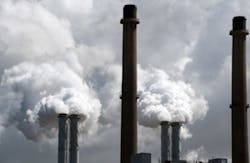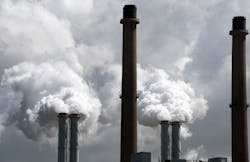The U.S. Environmental Protection Agency (EPA) today proposed Clean Air Act standards to cut carbon pollution from new power plants, an attempt to set the first cap on CO2 emissions from new power plant projects. Some critics of the proposal believe it is too costly to be implemented and would have a significant negative impact on the coal industry in the United States. (See: "Obama rule would block new coal plants lacking carbon capture")
The proposal is the first milestone outlined in President Obama’s June 25 Memorandum to the EPA on “Power Sector Carbon Pollution Standards,” a major part of the President’s Climate Action Plan. Under terms of the proposal, new natural gas-fired turbines would need to meet a limit of 1,000 pounds of CO2 per megawatt-hour, while new small natural gas-fired turbines would need to meet a limit of 1,100 pounds of CO2 per megawatt-hour. New coal-fired units would need to meet a limit of 1,100 pounds of CO2 per megawatt-hour, and would have the option to meet a somewhat tighter limit if they choose to average emissions over multiple years, giving those units additional operational flexibility.
RELATED: DOE Announces $8 Bil. Loan Program for Projects Aimed at Reducing Fossil Energy Emissions
According to the EPA, these proposed standards will ensure that new power plants are built with available clean technology to limit carbon pollution, a requirement that is in line with investments in clean energy technologies that are already being made in the power industry. Additionally, these standards provide flexibility by allowing sources to phase in the use of some of these technologies, and they ensure that the power plants of the future use cleaner energy technologies — such as efficient natural gas, advanced coal technology, nuclear power, and renewable energy like wind and solar.
In response to recent information and developments in the power sector and more than 2.5 million public comments, including those from the power sector and environmental groups, today’s proposal sets separate standards for new gas-fired and coal-fired power plants.
Power plants are the largest concentrated source of emissions in the United States, together accounting for roughly one-third of all domestic greenhouse gas emissions. Currently, nearly a dozen states have already implemented or are implementing their own market-based programs to reduce carbon pollution. In addition, more than 25 states have set energy efficiency targets, and more than 35 have set renewable energy targets. While the United States has limits in place for arsenic, mercury and lead pollution that power plants can emit, currently, there are no national limits on the amount of carbon pollution new power plants can emit.
U.S. Energy Secretary, Ernest Moniz, issued the following statement on the proposed EPA Carbon Pollution Standards:
"Today, the Environmental Protection Agency has taken a significant step in implementing President Obama’s Climate Action Plan by releasing its draft rule addressing future power plants. The power sector is a vital part of the solution to addressing climate change, one of the critical global issues of our time; this sector currently contributes about 40% of U.S. greenhouse gas emissions.
"To continue implementing the President’s Plan, the Department of Energy will work with our partners to further increase power plant efficiency across the range of generation types, promote advanced fossil energy technologies such as carbon capture, utilization, and storage (CCUS), and deploy more clean energy. DOE is also working to encourage the growth of advanced fossil energy technologies through a new process for $8 billion in loan guarantees for projects that avoid, reduce, or sequester air pollutants or greenhouse gas emissions. Since the beginning of the administration, DOE has already obligated around $6 billion dollars to advance clean coal technologies–particularly in CCU–that substantially reduce carbon emissions. We are continuing to build on the Administration’s successful energy efficiency standards, which are cutting energy bills for small businesses and families while also cutting carbon pollution. These programs are part of a real all-of-the-above clean energy strategy for a low carbon future where efficiency, coal, natural gas, nuclear and renewable sources all have an important role to play, and can successfully compete in a global marketplace.
"The EPA’s new draft rule is one of many actions the Obama Administration is taking under the President’s Climate Action Plan to cut carbon pollution in America, prepare the U.S. for the impacts of climate change, enable American competitiveness and job creation, and lead other countries in tackling this problem. The Department of Energy is committed to implementing the President’s Climate Action Plan with EPA and our other public and private sector partners."
For more information on the proposed Carbon Pollution Standars, click here.



